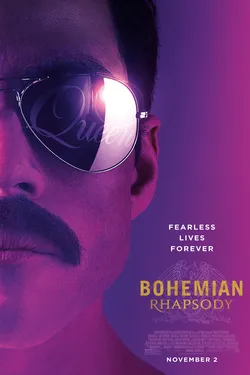Historical accuracy of Bohemian Rhapsody

Historical accuracy of Bohemian Rhapsody

Characters
Freddie Mercury (Rami Malek)
Malek captured Mercury's mannerisms and stage presence remarkably well (winning an Oscar). However, the film simplifies his personality and significantly alters the timeline of key life events.
Brian May (Gwilym Lee)
Portrayed accurately as a key member and songwriter, with Lee capturing May's look and demeanor well. May himself consulted on the film.
Roger Taylor (Ben Hardy)
Portrayed accurately as a core member and songwriter, involved in band dynamics. Taylor also consulted on the film.
John Deacon (Joseph Mazzello)
Portrayed accurately as the often reserved bassist and writer of key hits. His joining the band is slightly time-shifted in the film's opening sequence.
Mary Austin (Lucy Boynton)
Their deep, lifelong bond is accurately depicted, remaining crucial even after their romantic relationship ended. The circumstances of their first meeting are fictionalized.
Jim Hutton (Aaron McCusker)
Hutton was Mercury's real partner until his death. However, the film drastically changes how and when they met (depicting it much earlier than the actual meeting in 1985).
More characters
Paul Prenter (Allen Leech)
Accurately portrayed as a negative influence who isolated Freddie and later sold stories to the press. The timing of his dismissal is inaccurate (shown before Live Aid, happened after).
John Reid (Aidan Gillen)
Reid was Queen's manager (1975-1978). The film depicts Freddie firing him dramatically in a limo over suggesting a solo career; in reality, the split was amicable.
Jim Beach (Tom Hollander)
Accurately portrayed as the band's long-term lawyer and eventual manager ("Miami" Beach), who remained loyal to Queen.
Ray Foster (Mike Myers)
Entirely fictional character, likely an amalgam representing record executives who doubted "Bohemian Rhapsody." Reportedly loosely based on EMI chief Roy Featherstone (who actually liked Queen).
Story
Freddie Mercury joining the band "Smile"
The film shows Freddie meeting Brian May and Roger Taylor right after their singer quit. In reality, Freddie already knew them well and had lived with them.
John Deacon joining Queen
Deacon joined in 1971, but the film implies he was present at Freddie's first gig with the band in 1970.
Writing/recording "Bohemian Rhapsody" at Rockfield
Captures the experimental atmosphere and lengthy process of creating the iconic song, including the band's persistence despite studio doubts (though Ray Foster is fictional).
Timeline of song creation ("Fat Bottomed Girls", "WWRY")
Several songs are shown being written/performed out of chronological order for narrative effect (e.g., "Fat Bottomed Girls" shown on a 1974 tour but released in 1978; "We Will Rock You" shown in 1980s but released in 1977).
Freddie telling Mary Austin he is bisexual/gay
This conversation likely happened, reflecting the end of their romantic relationship but continuation of their friendship. The specific dialogue ("No Freddie, you're gay") is based on accounts.
Freddie's solo career causing Queen's break-up
A major inaccuracy. Queen never broke up. Freddie recorded his solo album while the band was on a break and still collaborating; other members also released solo work without splitting the band.
Freddie firing John Reid
The dramatic limo scene is fictional. Reid and Queen parted ways amicably in 1978.
Freddie firing Paul Prenter before Live Aid
Prenter was actually fired after Live Aid, reportedly in 1986, primarily for selling stories about Freddie to tabloids.
Freddie learning HIV diagnosis before Live Aid (1985)
One of the film's biggest timeline distortions. Mercury was likely diagnosed HIV positive around 1987, two years after Live Aid.
Freddie telling the band about HIV before Live Aid
Tied to the previous inaccuracy; the band likely learned of his diagnosis much later, around 1989.
Queen reuniting specifically for Live Aid
Since the band never broke up, there was no reunion for Live Aid. They had finished a tour just two months prior.
Live Aid performance depiction
The actual 20-minute performance at Live Aid is recreated with exceptional detail regarding staging, choreography, crowd interaction, and energy.
Setting
London Music Scene (1970s)
Captures the look and feel of the burgeoning rock scene, pubs, and clubs where Queen started.
Recording Studios (e.g., Rockfield Farm)
Represents the environments where Queen created their music, showing period-appropriate equipment and atmosphere.
Concert Venues & Touring Life
Showcases the progression from small gigs to massive stadium tours (like Rock in Rio - though its timing is inaccurate in the film), conveying the energy of live shows.
Live Aid Stage at Wembley (1985)
The physical recreation of the Live Aid stage, including details like drink cups on the piano, is noted for its accuracy.
Fashion and Hairstyles (1970s-1980s)
Costumes effectively track the evolution of the band's style and broader fashion trends from the glam rock 70s through the mid-80s.
Period Musical Equipment
Instruments, amplifiers, and studio gear shown appear consistent with the technology available in the respective eras.
Atmosphere of Rock Stardom
Conveys the pressures, excesses (parties), fan worship, and media attention associated with being one of the world's biggest rock bands.
Freddie Mercury's Homes (e.g., Garden Lodge)
Glimpses of Mercury's personal spaces are recreated to reflect his life off-stage.
